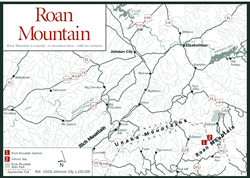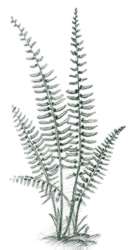 Roan
Mountain and Roan Mountain State Park
Roan
Mountain and Roan Mountain State Park  Roan
Mountain and Roan Mountain State Park
Roan
Mountain and Roan Mountain State Park [Fig. 15] Whether explored by car, on skis, through a vigorous hike, or on a leisurely ramble, Roan Mountain, with its caps of open grasslands, is thought by some to be the most beautiful mountain east of the Rockies.
The origins of its name also tell the story of the early pioneers here. Many of the English and Scottish settlers were unschooled and could not spell; their only book was the Bible. When they saw the mountain-ash tree, it reminded them of their European version, the Rowan tree. Over the years the name lost a syllable and became simply, "Roan."
One of the first to declare its beauty was Harvard botanist Asa Gray (see Naturalists), who studied the mountain's diverse plant life in 1841. André Michaux of France and plant collector John Fraser of Scotland also explored the mountain. All were attracted, as naturalists are today, to the region's unique treeless peaks, which are some of the largest expanses of grassy balds in the world, and to the wide representation of flora and fauna otherwise rarely found outside the mountains of eastern Canada.
Roan Mountain is actually a massif, or mountain mass, with two summits. It is part of a ridge known as the Roan Highlands, and is the highest peak in the Unaka Mountain Range. At its lower elevations, vegetation as southern as subtropical orchids can be found. But at the mountain's height, vestiges from the ice age remain, including wood sorrel (Oxalis montana), witch hobble (Viburnum alnifolium), and green alder (Alnus crispa), a species usually found in New England.
 In
June, Roan's open balds burst with the magenta-colored blooms of Catawba rhododendron,
which John Fraser designated Rhododendron catawbiense on this mountain
during his 1799 expedition. Each plant in the 600-acre spread of natural rhododendron
"gardens" might produce as many as 100 flowers.
In
June, Roan's open balds burst with the magenta-colored blooms of Catawba rhododendron,
which John Fraser designated Rhododendron catawbiense on this mountain
during his 1799 expedition. Each plant in the 600-acre spread of natural rhododendron
"gardens" might produce as many as 100 flowers.
The Roan Mountain–Rhododendron National Recreation Trail is an easy, 1-mile loop trail through the rhododendron gardens near Carvers Gap [Fig. 15(2)] on the North Carolina/Tennessee state line. The trail is actually in the form of three loops, the first one paved and ideal for handicapped visitors. An interpretive trail, this loop features 16 stations keyed to information in a brochure about the northern climate species and rare plants found here, such as spreading avens, hair cap moss, and Allegheny sand myrtle. The trail courses deep into Canadian-zone forests of red spruce, mountain-ash, Fraser fir, and wild berry bushes. It connects with the lower loops, which are also gradual and easy, making this an excellent trail for families and the elderly. An observation deck affords spectacular vistas that extend, on a clear day, to the Black Mountains and Great Craggie Mountains. Scientists have not determined why the range's peaks don't support trees, but theories abound. (For more information on balds, see Introduction to the Natural History of the North Carolina Mountains.)
The combination of heath balds, Canadian-zone spruce-fir forests, and, at lower elevations, hardwood coves, supports more than 1,500 species of native plants, flowers, herbs, trees, shrubs, ferns, club mosses, lichens, and mushrooms. Bird scholar Fred W. Behrend named the snow bunting (Plectrophenax nivalis) when he discovered it wintering on the balds. The area is also home to one of southern Appalachia's greatest concentrations of threatened, endangered, or sensitive plant and wildlife species, with nearly 30 identified, including Gray's lily, saxifrages, sedges, the saw-whet owl, and the northern flying squirrel. In 1941, 7,000 acres of this naturally significant area were incorporated into the Pisgah National Forest and Cherokee National Forest.
Though most of Roan Mountain is in North Carolina, 2,156 acres in a Tennessee valley on the mountain's north slope make up Roan Mountain State Park, an amenity-filled base for exploring the entire region. Camping, picnicking, and educational programs such as wildflower tours and bird walks reach their height during the June rhododendron festivals. And with 100 inches of annual snowfall, this is also the only state park in the south to offer cross-country skiing. Hiking trails course through the park and national forests. They accommodate enthusiasts looking for an easy stroll as well as others interested in trekking a stretch of the Appalachian Trail (see Appalachian Trail) on what is thought to be one of its most scenic sections. Hiking maps are available at the park office.